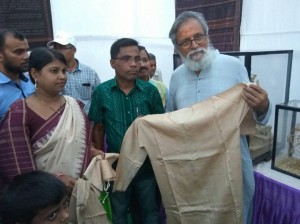 A kurta without a stitch: 39th Shodhyatra
A kurta without a stitch: 39th Shodhyatra
Imagine wearing a kurta in which there is no stitch, it would be difficult for us to think of it. But, a weaver Karna Mehr had actually woven a kurta as a cylindrical cloth. Another weaver Chukmani Mehr had woven poetry of Shri Gangadhar Mehr in the Barpali saree. Bhikhari Mehr had woven the Hanuman chalisa in sambalpuri saree. There were cases when a saree took 10 – 15 years to weave and requires single-minded devotion of the weavers. Numerous innovations in schools shows the constant search for reducing drudgery in various stages of double ikkat weaving. Praful and Ramprasad Mehr had developed manual and automatic and spinning and yarn winding machines respectively. Jitendriyabhai has developed a live detecting machine. Harilal Sahu made a bicycle operated water pump. An innovation which attracted a lot of attention was a a mouse trap that could catch 25 – 30 mice at a time. It was kept with a pipe attached to the rat hole in the in the night to trap them. Pidhambar Padhan designed a cotton seed separating machine. Minketan Nath designed a weeder. Srikara Seth had modified a laddering and planking system. Jaminikanth Dash had designed a diesel engine operated welding machine with 24 HP of engine consuming half the fuel and having double the light. Dananjya Sahu is a serial inventor. He developed an automatic bed for his physically challenged father-in-law, which had adjustable flaps, head and foot rest, wash basin, etc. He had also designed a solar sprayer. He was a very motivated school teacher and had designed many innovative methods for teaching mathematics to children. Sadhu Patel had designed a portable hand pump and Vibhuti Mund designed a pulveriser and a leaf drier.
As always, there were many creative ideas contributed by children. Vivekanand wanted an alarm in the toilets if somebody didn’t flush after use. Rinku had designed a model of portable borewell machine. Pinky and Himakanti conceived a utensil cleaning device. Vishnu wanted torch to be fitted in the shoes. Pramod would like a small fan to be powered by cell phone.
There were numerous agricultural innovations that we found in different villages. Subash Gartia developed a pesticide for brinjal and Sbhashini for paddy. Chinmay, Sriprasad Birender, Kishore, Harihar, Subash, Ramchandra and Diwan in differnet villages developed herbal pesticides. Kabir Chandra Sahu found an ingenous solutions for stopping flower shedding in pumpkin and water melon. Numerous paddy varieties were recalled in different villages such as jhili, yuvraj, sund kathi, karni, dengari, suan, sarihan, kulia, and sariyan dhan. A scented variety Tulsi Bassa was also recalled as something they missed very much. Gasi Ram Pradhan had developed a fruit ripener. In different villages, women brought numerous traditional recipes. Among the herbal medicines, there was one claim about a medicine which stopped nausea immediately. Many of these are under further investigation.
Given the pervasive nature of innovations as well as a vibrant tradition of local practices, there is a huge scope for value addition and enterprise development. We met the Chief Minister on 19th May and shared the key findings of our visit. There is a strong interest on the part of state government to operationalise the in-situ incubation model of innovation based startups. Bihar and Haryana governments have also shown interest in this model. The basic point is that young people having innovative ideas should be supported where they belong to. They can take care of their grandparents and at the same time pursue their entrepreneurial career. Distributed enterprises will generate jobs also in distributed manner. They can be affiliated to a virtual incubator such as the one established by NIF, SRISTI and GIAN. Periodically, these innovators can be invited for face to face meeting. Numerous ideas described here require support for product development. There should be a provision for such support along with mentoring to grassroots innovators, student innovators and other entrepreneurs. Without new product development, the startup will often deal with ‘me-too’ kind of businesses.
We plan to have next Shodhyatra in Andaman-Nikobar islands or in Uttrakhand. Those who want to join the Honey Bee Network and walk with us in different part of the country in the world are most welcome.

I I knew about SRISTI just before 2 nd half months…attended Kedut Samelan and Honey Bee Network Snehmilan in 1 may..also participated Unicef Sristi Summer Inovation at Grambharti. .just last 3 weeks…I knew lots of about all activities runs by Anil Sirji…I wish to join in next shodh yatra…plz informe about it..my mob. 99 240 90648
Want to join nxt shodh yatra..
Plz inform me on 99240 90648